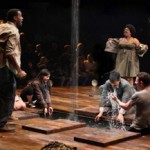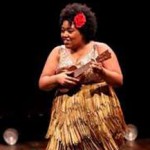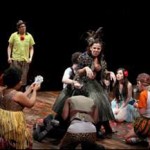Composer Stephen Schwartz and director John-Michael Tebelak conceived and wrote Godspell as Carnegie-Mellon University students in the early 1970s (almost all the lyrics are taken verbatim from the Gospels).
When it opened Off Broadway at LaMama in 1971, the Viet Nam War still raged; Charles Manson and his followers were being sentenced for the murder of Sharon Tate; Army Lieutenant William Calley was found guilty of the My Lai massacres; the New York Times had just begun publishing the Pentagon Papers; President Richard Nixon declared the “war on drugs”; Gloria Steinem addressed the women of America for one of her first times; Camden, New Jersey erupted in racial strife; and Walt Disney World opened in Orlando.
In other words, the U.S. was quite a different place, even though some of the intractable social issues roiling the nation then—like racism and sexism—continue to hound us now. Given its historical moment, this simple, sincere, ensemble musical must have seemed to respond to national crises with a subtle, quiet demonstration of faith in the power of community to offer comfort and support.
Meanwhile, American experimental theatre in the 1960s and ‘70s focused on ensemble physical interactions, using transformational acting techniques inspired by Viola Spolin’s theatre games that encouraged the actors to create all the stage images and set pieces with their bodies. Story-telling, direct address to the audience, a lack of psychology, a rejection of realism, and a determination to break the “fourth wall” between performers and spectators provided the aesthetic and political ethos of the day. (Feminist Spectator 2, Stacy Wolf, has an excellent chapter on 1970s musical theatre influenced by Spolin-style theatre games in her book, Changed for Good: A Feminist History of the Broadway Musical.)
Those theatre experiments (and, for that matter, 1971’s social cataclysms) have long been naturalized and incorporated into American political and theatre history. But here’s Godspell back on Broadway, in its first Broadway revival since it debuted there post-LaMama in 1976.
Because contemporary audiences haven’t seen much unadulterated, old-style transformational theatre on Broadway recently, the actors’ ability to create the environment with their bodies seems strangely new, even if it’s embellished now with fancy tricks of stage technology and sophisticated lighting techniques.
The production retains the late-1960s earnestness that marked it originally. But the revival gilds the show with wry, sarcastic patter and references to current events that seem at odds with the eager industriousness of the basic show, which hasn’t been significantly changed.
Godspell’s book remains structured around the parables Jesus tells his disciplines, who act them out with wit and sincerity, learning how to treat one another respectfully as they go. Played by the perky, blond, and glowing Hunter Parrish, Jesus is a beautiful and beatific white guy whose halo can practically be seen floating around his head.
By custom, John the Baptist/Judas Iscariot is played by a black man (here the terrific, specific, and sad Wallace Smith). This production conforms to a choice that maintains the typical dyad of white=good and black=bad/betrayer. In a production that tries so hard to update itself, with references to everything from the death of Steve Jobs and to Occupy Wall Street, it seems odd that director Daniel Goldstein and choreographer Christopher Gattelli would hang on to that tired racial binary.
Then again, other aspects of the production do seem refreshingly new, including a resolutely multiracial ensemble cast. Uzo Aduba, one of the show’s two African American female performers, even performs with a healthy dollop of masculinity, striking poses that show off her sculpted biceps, and bringing to “By My Side,” her signature song, a lovely sense of strength and compassion. Aduba was a pleasure to watch.
Likewise, the other four women in the 10-person cast performed their bits with equal vim, vigor, and charisma. Godspell would fall absolutely flat without performers who can sell the show’s good-humored, gentle fun and romantic singing.
All the characters remain types: The slightly blowsy Latina woman (Lindsay Mendez) who’s warm and earthy; the plus-size African American woman who measures her pulse rate after a particularly energetic number on little trampolines buried in the stage floor (Celisse Henderson); the rather slight white woman who nonetheless does a powerful “Turn Back O Man” (Morgan James); and the small, lithe Asian American woman (Anna Maria Perez de Tagle) who’s sweet and charming.
The men, too, are cut from familiar cloth. Telly Leung is terrific as the piano-playing Asian American male joker; Nick Blaemire is an intelligent, sweet presence as the white, Jewish-looking guy; and George Salazar fits in nicely as the burly, huggable bear of a Latino man. They’re all still physical and to a certain extent racial stereotypes, and as characters, they’re nothing but ciphers. But the ensemble works their performances to be appealing and very easy to watch.
This version of Godspell combines old, participatory 1960s-style experimental theatre tricks with the more recent trend to Blue Man Group-style theatrics and the participation ethos of reality TV. Audience members sitting close to the stage-in-the-round are hauled up to play characters (one man played Lazarus in one of the parables), or to play Pictionary (first published as a game in 1985), or to play Charades, in little vignettes that do little more than make other spectators wonder if they’ll be chosen to go up next.
The spectators who took the stage were all good-natured (and the Charade-player, at the matinee I saw, was remarkably talented). The cast, to the production’s credit, wasn’t bent on humiliating them. In fact, the actors basically whispered in each performing spectator’s ear, apparently telling them exactly what to do. Far from making anyone uncomfortable or embarrassed, the whole audience seemed buoyed by these invitations.
At another moment, spectators sitting on pillows right near the stage floor were instructed to hold up their decorated cushions for all to see. Those on one side of the house boasted images of heaven, those on the other, images of hell. Everyone seemed to think this was quite fun.
I admit I found it all a bit twee. But then, I was engrossed in my own reveries, as each song recalled for me some moment in my youth when I first heard and learned the music to Godspell. Our high school chorus (Peabody High, Pittsburgh, Class of ’75) performed a concert version of the score, in which, if I recall, I played the guitar and sang “By My Side” in a duet with another student. And I remember that an African American classmate who did “Turn Back O Man” got the vamping just right.
My own sentimentality about forty-year old memories preoccupied me throughout Godspell. But then again, I never found the musical’s book to be its most compelling aspect.
In fact, when I did find myself listening to Jesus and his parables at the Broadway revival, I was a bit concerned. Now that religion has become such a controversial touchstone in American politics, it’s hard to listen to a book and lyrics about Jesus and God and not think about evangelical Christianity and how hegemonic it’s become since the show debuted in 1971. Even thoughGodspell’s Jesus preaches tolerance, turning the other cheek, and loving one another, and although the ensemble warmly performs those friendly values, the show is still very much about the Judeo-Christian god in a way that made me uncomfortable.
Some of the theatre effects might have resonated more religiously than perhaps the producers intended. At the end, for example, a horizontal rod is lowered from the flies, onto which Hunter Parrish is lashed at the wrists. He crosses his ankles and tilts back his head in the iconic Jesus-on-the-crucifix pose. The rod rotates, so that the audience-in-the round can see this representation of his sacrificial pain.
At the finale , the cast releases him from the cross, lifting Parrish’s limp body in their arms and carrying him up the aisles, into the theatre lobby, which beckons with bright, heavenly light as they climb the theatre stairs. The day I saw Godspell, a few spectators along the way stood up in respect as the cast passed with their burden, in what seemed to me a cringe-worthy confusion of theatre and reality.
Perhaps no one ever really cared about Godspell’s religiosity, especially not when the music was so good and the stories were already rather bland. Godspell is carried by its songs, by its “poor theatre” theatricality, and by the stage presence of the collectively committed cast. In the original production, the show was also sold by Susan Tsu’s clown-like, playful costumes, which have set the show’s tone ever since.
But I do wonder what the producers were thinking when they decided to revive the show for Broadway now, when the extreme Right is forcing religion on this country as if it’s the only path to political, let alone spiritual, salvation.
I still love Godspell’s music, and the nice moments of fellow-feeling it inspires among its cast and its audiences. When Jesus hugs each of his disciplines good-bye towards the end, Parrish and the others communicate a moving measure of love and regret. The whole cast seems bonded, whether they’re performing playfully or sorrowfully.
The production uses stage technology and the tricks of theatricality to evoke its moments beautifully. At the show’s beginning, the stage floor opens onto channels of water, into which the actors jump and bathe in a proto-baptismal moment. A neat visual trick allows Jesus to appear to be walking on water, which gets an appropriate laugh.
At the end, the cast reopens those channels and, in unison, pours a powder into the water that makes it foam and steam, as though they’re sitting by the rushing rapids of a much larger river. These simple choices, of course, cost a lot of money, and are much fancier than the sawhorses and wood planks that were used to evoke locations and scenes in the original production. But still, the revival’s stagecraft produced visually and emotionally resonant images.
Feminist Spectator 2 tells me that Godspell’s score sounded like it was re-orchestrated, and that more electric music was added for this revival. Although my less formally schooled ears couldn’t quite pick up what was different, I missed the more acoustic guitar riffs.
The six-person band was spread out on small individual platforms around the house, while the conductor sat on the stage at a piano that became part of the action. Because the band was, of course, amplified, I was at times confused about where the music was coming from; it took me a moment to pick out all the musicians at their various stages (or stations? of the cross?) in the house.
I enjoyed my afternoon at Godspell, which Stacy and I saw with two of our 12-year-old nieces and with my sisters- and brother-in-law and my mother-in-law. We had fun. All of the adults indulged their many memories of earlier productions as spectators and performers. And the girls, who didn’t know the show, said it was “good,” noncommittally, though they were happy to wait for cast autographs afterwards.
One of our nieces did notice that the actors were close to the audience and actually looked at us, unlike, in her example, Wicked, in which the “actors were so far away and there is a dividing line between the show and the audience.” Seems that audience participation, direct address, and theatre-in-the-round do make an impression . . .
But what does Godspell mean, now? That we should live by Jesus’s teachings? That we should love one another the way he preached? That we should be a rainbow of difference and create community among us? What kind of difference or community does this revival have in mind, exactly? I left the theatre not at all sure what the production wanted us to do, besides humming the wonderful songs, thinking about the performances, and watching the actors come out to sign programs.
I have a feeling Godspell meant a bit more than that in 1971, at LaMama, and even in 1976, when it debuted on Broadway.
I wish it meant more now.
The Feminist Spectator
Godspell, Circle in the Square Theatre, Sunday matinee, November 14, 2011.




Maybe part of the point in reviving Godspell now is to remind audiences that once upon a time not all that long ago religion was allied with progressive political goals such as civil rights, economic justice, and peace. In addition to the black church, my typist recalls that for a brief time in the early to mid 70s, there were hippie Christians — self-described Jesus Freaks — who were all about peace and love rather than fire and brimstone. Godspell seems to have emerged out of that movement. It would be nice if the show’s revival made a few folks pause to consider the possibility that Jesus probably wouldn’t be a right-wing lunatic if he were around today. Pretty to think so, isn’t it?
Hey, thanks for writing, Roxie, this is very insightful and useful. Would that the show were recalling those values, and modeling how to re-infuse religious discourse with those of peace and economic justice. I think the show’s casting might be an effort to signal that. But I wonder if its very earnestness makes it seem anachronistic in a way that would undermine the suggestion of a resurrection (if you will) of those progressive values. That is, it seems so out of place and time in some respects, I’m not sure it means us to re-embrace the very values you suggest, or to see them as cultural museum pieces that are now irrelevant. I’d love to hear what others think, too, and so appreciate your engagement. Yrs, jd
I was thinking along the same lines as Roxie, perhaps because, although I first saw Godspell in a theater, I came to know it through repeat (scaled-down) performances as part of a church choir (in a church led by a pastor who had spent a summer during seminary marching and being arrested in the south during the civil rights movement, and who still, in the early ’70s, wore long hair and a beard and drove a VW van, and gently nudged at his suburban congregation’s fairly comfortable middle-class lives and values on a regular basis, aided, at least in the case of Godspell, by a then-still-mostly-in-the-closet gay choirmaster). The book is, indeed, drawn directly from the gospels, and especially, I believe, from Matthew, which is perhaps the most social-justice-oriented of the four. It’s also the one that puts particular emphasis on Jesus’ conflicts with the pharisees, by-the-book religious types whom he calls “hypocrites” (in a wonderful rant that makes it into the musical) — an appealing message in the early ’70s, and perhaps one that also resonates today.
So, for me, staging Godspell in the age of the Occupy movement seems very appropriate. But it may take a certain amount of Biblical literacy to make the connection, and I’m not sure many teenagers and young adults (including, sadly, those who have gone through our Sunday School and confirmation classes) would make the connection.
On the other hand, conservative Christians tend to be more familiar with the Bible, and they may be discomfited by the show’s reminders that Jesus hung out with outcasts and those the religious establishment considered sinners(part of the point of the opening sequence, including the costumes, I think), and generally questioned the establishments of his day. That was certainly true in the ’70s (many conservative Christians strongly disliked its portrait of Jesus), and might still be true today. If so, maybe the show still speaks to some of the people who most need to hear its message.